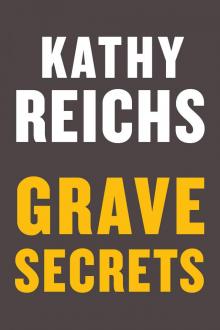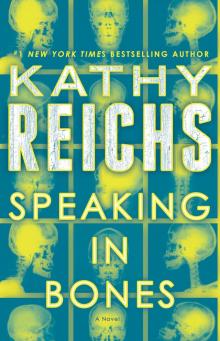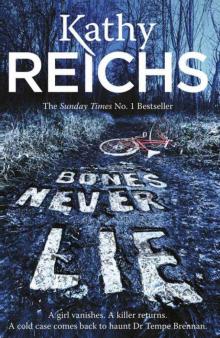- Home
- Kathy Reichs
Bones Are Forever tb-15
Bones Are Forever tb-15 Read online
Bones Are Forever
( Temperance Brennan - 15 )
Kathy Reichs
Kathy Reichs, #1 New York Times bestselling author and producer of the FOX televison hit Bones, is at her brilliant best in a riveting novel featuring forensic anthropologist Tempe Brennan—a story of infanticide, murder, and corruption, set in the high-stakes, high-danger world of diamond mining.
A woman calling herself Amy Roberts checks into a Montreal hospital complaining of uncontrolled bleeding. Doctors see evidence of a recent birth, but before they can act, Roberts disappears. Dispatched to the address she gave at the hospital, police discover bloody towels outside in a Dumpster. Fearing the worst, they call Temperance Brennan to investigate.
In a run-down apartment Tempe makes a ghastly discovery: the decomposing bodies of three infants. According to the landlord, a woman named Alma Rogers lives there. Then a man shows up looking for Alva Rodriguez. Are Amy Roberts, Alma Rogers, and Alva Rodriguez the same person? Did she kill her own babies? And where is she now?
Heading up the investigation is Tempe’s old flame, homicide detective Andrew Ryan. His counterpart from the Royal Canadian Mounted Police is sergeant Ollie Hasty, who happens to have a little history with Tempe himself, which she regrets. This unlikely trio follows the woman’s trail, first to Edmonton and then to Yellowknife, a remote diamond-mining city deep in the Northwest Territories. What they find in Yellowknife is more sinister than they ever could have imagined.
Crackling with sexual tension, whip-smart dialogue, and the startling plot twists Reichs delivers so well, Bones Are Forever is the fifteenth thrilling novel in Reichs’s “cleverly plotted and expertly maintained series” (The New York Times Book Review). With the FOX series Bones in its eighth season and her popularity at its broadest ever, Kathy Reichs has reached new heights in suspenseful storytelling.
For my very, very old friend Bob “Airborne” Abel
Acknowledgments
I would like to thank Gilles Ethier, Chief Deputy coroner of Quebec, for information pertaining to laws covering the disposal of deceased infants in the province. Dr. Robert Dorion, Dr. Michael Baden, and Dr. Bill Rodriguez helped with aspects of forensic science outside my specialty.
At the RCMP, Sgt. Valerie Lehaie and Cpl. Leander Turner shared information concerning Project KARE and the Alberta Missing Persons and Unidentified Human Remains project. John Yee provided valuable contacts. Judy Jasper answered a myriad of questions.
At the Giant Mine Remediation Project, Tara Kramers, Environmental Scientist, and Ben Nordahn, Mine Systems Officer, led me deep underground on a kick-ass tour of the Giant Gold Mine. Tara responded to my many follow-up queries.
Cathie Bolstad of De Beers Canada replied to my inquiry about exploration and staking. Gladys King took my call at the Mining Records Office in Yellowknife.
Mike Warns and Ronnie Harrison helped with scores of picky little details.
Kevin Hanson and Amy Cormier of Simon and Schuster Canada made my trip to Yellowknife possible. Judith and Ian Drinnan, Annaliese Poole, Larry Adamson, Jamie Bastedo, and Colin Henderson were warm and generous hosts at the NorthWords Literary Festival.
I appreciate the continued support of Chancellor Philip L. Dubois of the University of North Carolina–Charlotte.
Heartfelt thanks to my agent, Jennifer Rudolph Walsh, and to my editors, Nan Graham and Susan Sandon. I also want to acknowledge all those who work so very hard on my behalf, including Lauren Lavelle, Paul Whitlatch, Rex Bonomelli, Daniel Burgess, Simon Littlewood, Tim Vanderpump, Emma Finnigan, Rob Waddington, Glenn O’Neill, Kathleen Nishimoto, Caitlin Moore, Tracy Fisher, Michelle Feehan, Cathryn Summerhayes, Raffaella De Angelis, and the whole Canadian crew.
I am grateful to my family for putting up with my moods and absences. Paul Reichs read and commented on the manuscript when he really wanted to get on with retirement.
Fire into Ice: Charles Fipke and the Great Diamond Hunt, Vernon Frolick, 2002, Raincoast Books, and Treasure Under the Tundra: Canada’s Arctic Diamonds, L. D. Cross, 2011, Heritage House, were useful resources.
Most of all, big thanks go out to my readers. I appreciate you reading about Tempe, coming to my talks and signings, visiting my website (KathyReichs.com), liking me on Facebook, and following me on Twitter (@kathyreichs). Love you, guys!
If I forgot someone, I am really, really sorry. If I made mistakes, they are my fault.
THE BABY’S EYES STARTLED ME. SO ROUND AND WHITE AND pulsing with movement.
Like the tiny mouth and nasal openings.
Ignoring the maggot masses, I inserted gloved fingers beneath the small torso and gently lifted one shoulder. The baby rose, chin and limbs tucked tight to its chest.
Flies scattered in a whine of protest.
My mind took in details. Delicate eyebrows, almost invisible on a face barely recognizable as human. Bloated belly. Translucent skin peeling from perfect little fingers. Green-brown liquid pooled below the head and buttocks.
The baby was inside a bathroom vanity, wedged between the vanity’s back wall and a rusty drainpipe looping down from above. It lay in a fetal curl, head twisted, chin jutting skyward.
It was a girl. Shiny green missiles ricocheted from her body and everything around it.
For a moment I could only stare.
The wiggly-white eyes stared back, as though puzzled by their owner’s hopeless predicament.
My thoughts roamed to the baby’s last moments. Had she died in the darkness of the womb, victim of some heartless double-helix twist? Struggling for life, pressed to her mother’s sobbing chest? Or cold and alone, deliberately abandoned and unable to make herself heard?
How long does it take for a newborn to give up life?
A torrent of images rushed my brain. Gasping mouth. Flailing limbs. Trembling hands.
Anger and sorrow knotted my gut.
Focus, Brennan!
Easing the miniature corpse back into place, I drew a deep breath. My knee popped as I straightened and yanked a spiral from my pack.
Facts. Focus on facts.
The vanity top held a bar of soap, a grimy plastic cup, a badly chipped ceramic toothbrush holder, and a dead roach. The medicine cabinet yielded an aspirin bottle containing two pills, cotton swabs, nasal spray, decongestant tablets, razor blades, and a package of corn-remover adhesive pads. Not a single prescription medication.
Warm air moving through the open window fluttered the toilet paper hanging beside the commode. My eyes shifted that way. A box of tissue sat on the tank. A slimy brown oval rimmed the bowl.
I swept my gaze left.
Lank fabric draped the peeling window frame, a floral print long gone gray. The view through the dirt-crusted screen consisted of a Petro-Canada station and the backside of a dépanneur.
Since I entered the apartment, my mind had been offering up the word “yellow.” The mud-spattered stucco on the building’s exterior? The dreary mustard paint on the inside stairwell? The dingy maize carpet?
Whatever. The old gray cells kept harping. Yellow.
I fanned my face with my notebook. Already my hair was damp.
It was nine A.M., Monday, June 4. I’d been awakened at seven by a call from Pierre LaManche, chief of the medico-legal section at the Laboratoire de sciences judiciaires et de médecine légale in Montreal. LaManche had been roused by Jean-Claude Hubert, chief coroner of the province of Quebec. Hubert’s wake-up had come from an SQ cop named Louis Bédard.
According to LaManche, Caporal Bédard had reported the following:
At approximately two-forty A.M. Sunday, June 3, a twenty-seven-year-old female named Amy Roberts presented at the Hôpital Honoré-Mercier in Saint-Hyacinthe complaining of excessive vaginal
bleeding. The ER attending, Dr. Arash Kutchemeshgi, noted that Roberts seemed disoriented. Observing the presence of placental remnants and enlargement of the uterus, he suspected she had recently given birth. When asked about pregnancy, labor, or an infant, Roberts was evasive. She carried no ID. Kutchemeshgi resolved to phone the local Sûreté du Québec post.
At approximately three-twenty A.M., a five-car pileup on Autoroute 20 sent seven ambulances to the Hôpital Honoré-Mercier ER department. By the time the blood cleared, Kutchemeshgi was too exhausted to remember the patient who might have delivered a baby. In any case, by then the patient was gone.
At approximately two-fifteen P.M., refreshed by four hours of sleep, Kutchemeshgi remembered Amy Roberts and phoned the SQ.
At approximately five-ten P.M., Caporal Bédard visited the address Kutchemeshgi had obtained from Roberts’s intake form. Getting no response to his knock, he left.
At approximately six-twenty P.M., Kutchemeshgi discussed Amy Roberts with ER nurse Rose Buchannan, who, like the doctor, was working a twenty-four-hour shift and had been present when Roberts arrived. Buchannan recalled that Roberts simply vanished without notifying staff; she also thought she remembered Roberts from a previous visit.
At approximately eight P.M., Kutchemeshgi did a records search and learned that Amy Roberts had come to the Hôpital Honoré-Mercier ER eleven months earlier complaining of vaginal bleeding. The examining physician had noted in her chart the possibility of a recent delivery but wrote nothing further.
Fearing a newborn was at risk, and feeling guilty about failing to follow through promptly on his intention to phone the authorities, Kutchemeshgi again contacted the SQ.
At approximately eleven P.M., Caporal Bédard returned to Roberts’s apartment. The windows were dark, and as before, no one came to the door. This time Bédard took a walk around the exterior of the building. Upon checking a Dumpster in back, he spotted a jumble of bloody towels.
Bédard requested a warrant and called the coroner. When the warrant was issued Monday morning, Hubert called LaManche. Anticipating the possibility of decomposed remains, LaManche called me.
So.
On a beautiful June day, I stood in the bathroom of a seedy third-floor walk-up that hadn’t seen a paintbrush since 1953.
Behind me was a bedroom. A gouged and battered dresser occupied the south wall, one broken leg supported by an inverted frying pan. Its drawers were open and empty. A box spring and mattress sat on the floor, dingy linens surrounding them. A small closet held only hangers and old magazines.
Beyond the bedroom, through folding double doors—the left one hanging at an angle from its track—was a living room furnished in Salvation Army chic. Moth-eaten sofa. Cigarette-scarred coffee table. Ancient TV on a wobbly metal stand. Chrome and Formica table and chairs.
The room’s sole hint of architectural charm came from a shallow bay window facing the street. Below its sill, a built-in tripartite wooden bench ran to the floor.
A shotgun kitchen, entered from the living room, shared a wall with the bedroom. On peeking in earlier, I’d seen round-cornered appliances resembling those from my childhood. The counters were topped with cracked ceramic tile, the grout blackened by years of neglect. The sink was deep and rectangular, the farmhouse style now back in vogue.
A plastic bowl on the linoleum beside the refrigerator held a small amount of water. I wondered vaguely about a pet.
The whole flat measured maybe eight hundred square feet. A cloying odor crammed every inch, fetid and sour, like rotting grapefruit. Most of the stench came from spoiled garbage in a kitchen waste pail. Some came from the bathroom.
A cop was manning the apartment’s only door, open and crisscrossed with orange tape stamped with the SQ logo and the words Accès interdit—Sûreté du Québec. Info-Crime. The cop’s name tag said Tirone.
Tirone was in his early thirties, a strong guy gone to fat with straw-colored hair, iron-gray eyes, and apparently, a sensitive nose. Vicks VapoRub glistened on his upper lip.
LaManche stood beside the bay window talking to Gilles Pomier, an LSJML autopsy technician. Both looked grim and spoke in hushed tones.
I had no need to hear the conversation. As a forensic anthropologist, I’ve worked more death scenes than I care to count. My specialty is decomposed, burned, mummified, dismembered, and skeletal human remains.
I knew others were speeding our way. Service de l’identité judiciaire, Division des scènes de crime, Quebec’s version of CSI. Soon the place would be crawling with specialists intent on recording and collecting every fingerprint, skin cell, blood spatter, and eyelash present in the squalid little flat.
My eyes drifted back to the vanity. Again my gut clenched.
I knew what lay ahead for this baby who might have been. The assault on her person had only begun. She would become a case number, physical evidence to be scrutinized and assessed. Her delicate body would be weighed and measured. Her chest and skull would be entered, her brain and organs extracted and sliced and scoped. Her bones would be tapped for DNA. Her blood and vitreous fluids would be sampled for toxicology screening.
The dead are powerless, but those whose passing is suspected to be the result of wrongdoing by others suffer further indignities. Their deaths go on display as evidence transferred from lab to lab, from desk to desk. Crime scene technicians, forensic experts, police, attorneys, judges, jurors. I know such personal violation is necessary in the pursuit of justice. Still, I hate it. Even as I participate.
At least this victim would be spared the cruelties the criminal justice machine reserves for adult victims—the parading of their lives for public consumption. How much did she drink? What did she wear? Whom did she date? Wouldn’t happen here. This baby girl never had a life to put under the microscope. For her, there would be no first tooth, no junior prom, no questionable bustier.
I flipped a page in my spiral with one angry finger.
Rest easy, little one. I’ll watch over you.
I was jotting a note when an unexpected voice caught my attention. I turned. Through the cockeyed bedroom door, I saw a familiar figure.
Lean and long-legged. Strong jaw. Sandy hair. You get the picture.
For me, it’s a picture with a whole lot of history.
Lieutenant-détective Andrew Ryan, Section de crimes contre la personne, Sûreté du Québec.
Ryan is a homicide cop. Over the years, we’ve spent a lot of time together. In and out of the lab.
The out part was over. Didn’t mean the guy wasn’t still smoking hot.
Ryan had joined LaManche and Pomier.
Jamming my pen into the wire binding, I closed my spiral and walked to the living room.
Pomier greeted me. LaManche raised his hound-dog eyes but said nothing.
“Dr. Brennan.” Ryan was all business. Our MO, even in the good times. Especially in the good times.
“Detective.” I stripped off my gloves.
“So. Temperance.” LaManche is the only person on the planet who uses the formal version of my name. In his starched, proper French, it comes out rhyming with “France.” “How long has this little person been dead?”
LaManche has been a forensic pathologist for over forty years and has no need to query my opinion on postmortem interval. It’s a tactic he employs to make colleagues feel they are his equals. Few are.
“The first wave of flies probably arrived and oviposited within one to three hours of death. Hatching could have begun as early as twelve hours after the eggs were laid.”
“It’s pretty warm in that bathroom,” Pomier said.
“Twenty-nine Celsius. At night it would have been cooler.”
“So the maggots in the eyes, nose, and mouth suggest a minimum PMI of thirteen to fifteen hours.”
“Yes,” I said. “Though some fly species are inactive after dark. An entomologist should determine what types are present and their stage of development.”
Through the open window, I heard a siren wail
in the distance.
“Rigor mortis is maximal,” I added, mostly for Ryan’s benefit. The other two knew that. “So that’s consistent.”
Rigor mortis refers to stiffening due to chemical changes in the musculature of a corpse. The condition is transient, beginning at approximately three hours, peaking at approximately twelve hours, and dissipating at approximately seventy-two hours after death.
LaManche nodded glumly, arms folded over his chest. “Placing possible time of death somewhere between six and nine o’clock last night.”
“The mother arrived at the hospital around two-forty yesterday morning,” Ryan said.
For a long moment no one spoke. The implication was too sad. The baby might have lived over fifteen hours after her birth.
Discarded in the cabinet? Without so much as a blanket or towel? Once more I pushed the anger aside.
“I’m finished,” I said to Pomier. “You can bag the body.”
He nodded but didn’t move away.
“Where’s the mother?” I asked Ryan.
“Appears she may have split. Bédard is running down the landlord and canvassing the neighbors.”
Outside, the siren grew louder.
“The closet and dresser are empty,” I said. “There are few personal items in the bathroom. No toothbrush, toothpaste, deodorant.”
“You’re assuming the heartless bitch bothered with the niceties of hygiene.”
I glanced at Pomier, surprised by the bitterness in his tone. Then I remembered. Pomier and his wife had been trying to start a family. Four months earlier she’d miscarried for the second time.
The siren screamed its arrival up the street and cut off. Doors slammed. Voices called out in French. Others answered. Boots clanged on the iron stairs leading to the first floor from the sidewalk.
Shortly, two men slipped under the crime scene tape. Uniform jumpsuits. I recognized both: Alex Gioretti and Jacques Demers.
Trailing Gioretti and Demers was an SQ corporal I assumed to be Bédard. His eyes were small and dark behind wire-rimmed glasses. His face was blotchy with excitement. Or exertion. I guessed his age to be mid-forties.

 Two Nights
Two Nights The Bone Collection: Four Novellas
The Bone Collection: Four Novellas Fatal Voyage
Fatal Voyage 206 Bones
206 Bones Bones to Ashes
Bones to Ashes Terminal
Terminal Monday Mourning
Monday Mourning Flash and Bones
Flash and Bones Cross Bones
Cross Bones Devil Bones
Devil Bones Break No Bones
Break No Bones Swamp Bones
Swamp Bones Déjà Dead
Déjà Dead Shock
Shock Spider Bones
Spider Bones Death Du Jour
Death Du Jour Grave Secrets
Grave Secrets Trace Evidence: A Virals Short Story Collection
Trace Evidence: A Virals Short Story Collection Bones on Ice
Bones on Ice The Bone Code
The Bone Code Bones in Her Pocket
Bones in Her Pocket Seizure:
Seizure: Speaking in Bones
Speaking in Bones Deadly Decisions
Deadly Decisions Spike
Spike Bones Never Lie
Bones Never Lie Bones of the Lost
Bones of the Lost Virals 03.5 - Swipe
Virals 03.5 - Swipe Exposure
Exposure A Conspiracy of Bones
A Conspiracy of Bones Shift (tory brennan)
Shift (tory brennan) Bones of the Lost: A Temperance Brennan Novel tb-16
Bones of the Lost: A Temperance Brennan Novel tb-16 Virals tb-1
Virals tb-1 Bones Are Forever tb-15
Bones Are Forever tb-15 Code tb-3
Code tb-3 Seizure tb-2
Seizure tb-2 Deadly Descisions
Deadly Descisions Spider Bones: A Novel
Spider Bones: A Novel